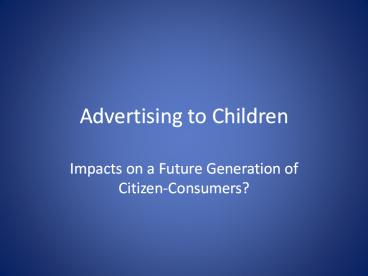Advertising to Children - PowerPoint PPT Presentation
1 / 22
Title:
Advertising to Children
Description:
... (1997) Consuming Kids: The Commercialization of Childhood (Media Education ... Underneath them is an early ... org/wiki/Channel_One_News#Controversy ... – PowerPoint PPT presentation
Number of Views:346
Avg rating:3.0/5.0
Title: Advertising to Children
1
Advertising to Children
- Impacts on a Future Generation of
Citizen-Consumers?
2
Texts and Topics
- Juliet Schor, Born to Buy The Commercialized
Child and the New Consumer Culture (2004) - Malcolm Gladwell, The Coolhunt (1997)
- Consuming Kids The Commercialization of
Childhood (Media Education Foundation, 2008)
3
(No Transcript)
4
Anti-adultism
5
(No Transcript)
6
More than 1.6 billion is spent by food and
beverage companies each year on marketing
products to younger consumers, according to
Federal Trade Commission figures. Research
conducted by Yales Rudd Center for Food Policy
and Obesity found that Children prefer the
taste of foods branded with images of popular
cartoon characters and choose those foods more
often than unbranded ones. This goes to show
that kids prefer a vibrant and fun product over a
mundane item. http//ajstrat.wordpress.com/2010/10
/20/new-forms-of-food-advertisements-are-reaching-
out-to-kids/. 10 Oct. 2010
7
(No Transcript)
8
(No Transcript)
9
(No Transcript)
10
http//www.girlsintelligenceagency.com/
11
(No Transcript)
12
(No Transcript)
13
(No Transcript)
14
(No Transcript)
15
(No Transcript)
16
(No Transcript)
17
Ad industrys three lines of defense
- they are empowering kids
- advertising to kids is necessary for the economic
health of the industry - parents are the guilty party
www.thebettermom.com
18
Schor discusses Channel One, 86-88
19
Decommercializing Childhood
- Advocate for legislation that would more highly
regulate advertising and the media - Become aware of the types of advertising
- taking place in schools
- Become more aware of commercialization in the home
20
(No Transcript)
21
- Why do your clients hire you guys? What are they
looking for? What do they do with the information
you give them? - Dee Dee Gordon I think they're looking to us
to be kind of the eyes and ears of youth culture.
It's a difficult job. You can't understand a
whole culture by checking in every now and then
or a phone here or an article there. So they kind
of rely on us as a resource to say, "This is
what's going on" all the time, to give them kind
of a pulse. - ...For instance, we have some clients who are
interested in taking a product that already
exists and finding a way that it can appeal to
young people. So they will use our information to
find out if that product is even interesting to
them or if there's a way that they could make it
more interesting. Same thing with advertising.
They like to test whether or not their
advertising is relevant to these kids or what
kind of advertising is relevant, so that they can
do something similar. Or let's say they want to
like create a whole new brand or a whole new
product with a company that targets a specific
audience. They take out information to assist in
inspiring project designers, in helping them
market the new product, even in naming the
product, and then eventually testing. They use
our database to recruit kids to test the products
out, stuff like that. - http//www.pbs.org/wgbh/pages/frontline/shows/cool
/etc/hunting.html
22
- ...How does a trend spread?
- SharonLee ...Actually it's a triangle. At the
top of the triangle there's the innovator, which
is like two to three percent of the population.
Underneath them is the trend-setter, which we
would say is about 17 percent. And what they do
is they pick up on ideas that the innovators are
doing and they kind of claim them as their own.
Underneath them is an early adopter, which is
questionable exactly what their percentage is,
but they kind of are the layer above mainstream,
which is about 80 percent. And what they do is
they take what the trend-setter is doing and they
make it palatable for mass consumption. They take
it, they tweak it, they make it more acceptable,
and that's when the mass consumer picks up on it
and runs with it and then it actually kills it. - http//www.pbs.org/wgbh/pages/frontline/shows/cool
/etc/hunting.html































